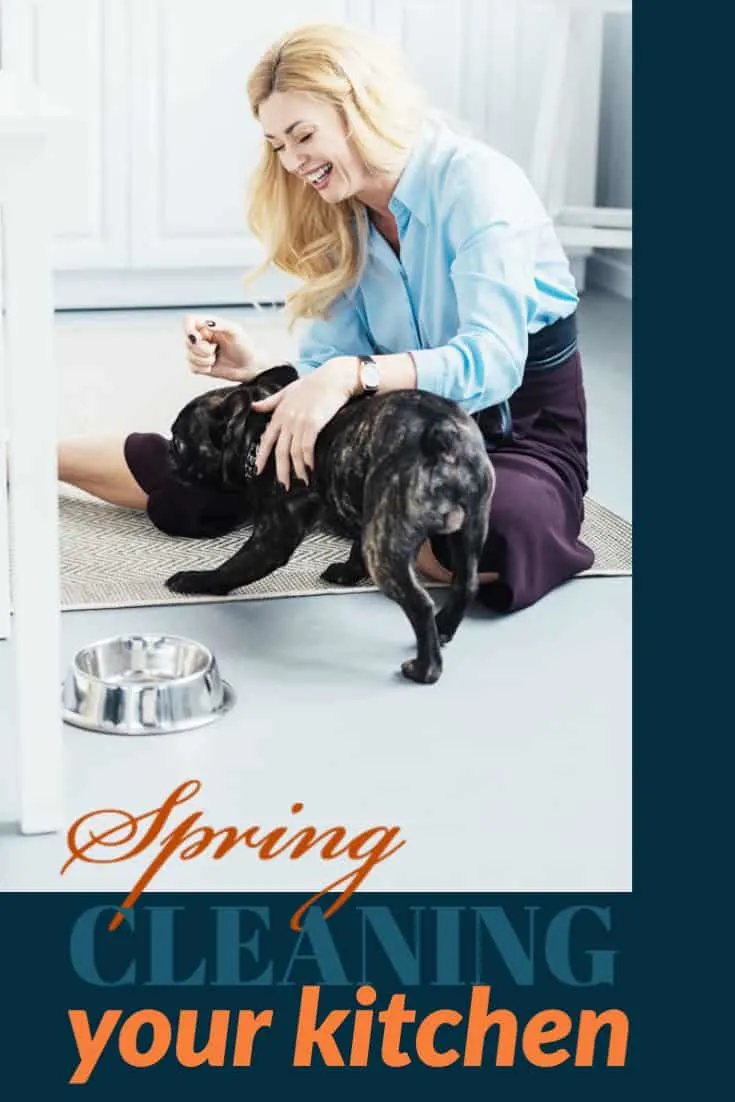Kitchens are not just the place where we make our own food–but also the place where we prepare, serve, and store our pets’ foods. Although they may not be as large as some of the other rooms in our homes (our kitchen is one of the smallest rooms in our house, in spite of being the place where we’ve written six cookbooks!), the spring cleaning task here is a big job.

Any food can carry the Salmonella bacteria, including cooked pet foods. (In fact, the risk of Salmonella bacteria in foods in one of the most frequent reasons for pet food recalls.)
Because of that risk, it’s especially important for pet homes to keep a clean kitchen, from countertops to cabinets to the kitchen floor.
As with spring cleaning of other rooms like bedrooms, spring cleaning the kitchen is done top to bottom, starting with the ceiling. As with other rooms, it’s best to put pets in another room then open windows and doors for fresh air during this often-dusty job.
Start with the ceiling and walls
- Use a broom and remove any cobwebs in ceiling corners.
- Remove any curtains or window treatments and launder.
- Dust tops of cabinets if they don’t reach the ceiling.
- Wipe down walls to remove dust and grease (and, therefore, attached fur.)
- Dust the top of the refrigerator.
- Dust any photos and ornaments (or wash, if they’re greasy).
- Using a microfiber cloth damp with vinegar and water, wipe down all walls, top to bottom.
- Wash light switchplates with mild detergent or vinegar and water.
Clean countertops and backsplashes
- Wash countertop and backsplash with vinegar solution (50% white vinegar, 50% hot water).
- Wash microwave with vinegar solution.
- Wash all cabinet fronts with vinegar solution.
- Clean oven with paste made from baking soda and water.
- Clean any grout with baking soda and water paste.
Clean the refrigerator
- Clean the exterior of your stove and refrigerator with vinegar and water mixture or make a spray of warm water with a few drops of natural dishwashing liquid.
- Clean the interior of the refrigerator. Throw away any old food; remove each shelf individually and wash it with detergent or vinegar/water.
- Add a new box of baking soda to the refrigerator to remove all odors naturally.
Clean the cabinets
- Clean kitchen cabinets. Wipe each down with vinegar mixture.
- Box up utensils you no longer use to donate.
- Clean kitchen drawers. We have drawers set aside for the pets, including medications.
- Clean out pet medications and discard outdated medications and treats, etc.
- Wipe down each drawer.
Clean the pantry and trash bins
- Clean out your pantry, throwing away post-dated foods.
- Sanitize your kitchen trash can and the area around the trash can. Clean with a vinegar mixture.
Inventory and clean pet products
- Take stock of your pet foods and treats. Put the foods with the closest expiration dates at the front of your pantry shelves, moving newer food to the back of the pantry.
- You can also freeze most dry pet food to extend its lifespan. (See our posts on pet food storage and dog treat storage for more details.)
- Do a deep cleaning of your pet’s fountain. If it’s not dishwasher-safe, run a vinegar and water solution through the fountain, scrub and remove all deposits.
- Check all your pet bowls and plates. Discard any plates and bowls with deep cuts and nicks that will harbor bacteria. Donate any you no longer use.
- How to Calm a Dog During Fireworks - June 20, 2024
- Taking Your Dog to See Santa: Tips for a Jolly Visit! - December 7, 2023
- The Pug Dog Price Tag: What You Need to Know Before You Get Your Pug - September 7, 2022
